Such a structure as a cellar is often settled in the country, under the house or an outbuilding. The cellar is used for storing fresh food and preservation, and for it to work efficiently, it must have the right microclimate. An important element of its provision is the hood in the cellar: how to make the ventilation correct – you can learn from the numerous instructions and thematic video clips. Ventilation can be natural and forced.
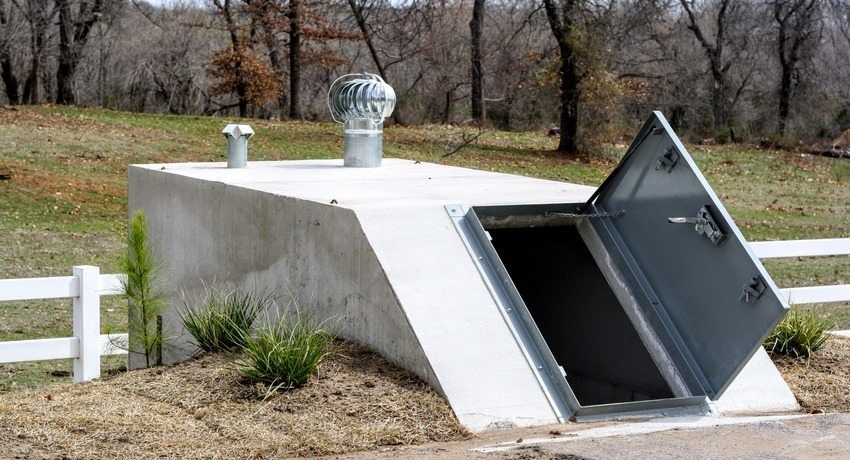
The device hoods in the cellar
There are several options for ensuring the microclimate in the storage with the help of ventilation. Air circulation can occur naturally, or maybe with the help of special fans. In addition, the ventilation system can be equipped with additional devices that will increase the efficiency of its operation.

The main element of any ventilation system is a pipe. They are usually two:
- Exhaust pipe – through it the air comes out of the room. It is mounted in the upper corner of the basement, and it should protrude about 0.5 m above the ridge. Condensate can accumulate in the exhaust pipe, so it must be further warmed with mineral wool or other materials.
- The inlet pipe – serves for the inflow of fresh air into the storage, is mounted in the corner opposite to the exhaust pipe. The opening of the inlet pipe should be located approximately 40-60 cm from the floor of the cellar, and its outer end should be significantly elevated above ground level.
In addition to pipes, in arranging the air ventilation system, valves, fans, deflectors, as well as special climatic equipment are used, if necessary.
The easiest way to ensure optimum temperature and fresh air in the basement is to install natural ventilation.

When arranging proper ventilation of the cellar in a natural way, you will receive the following benefits:
- Low cost design. When installing natural ventilation, you only spend money on building materials, which are not so much needed for it.
- The possibility of installing the system not only during the construction of the basement, but also after its completion.
- Easy installation. It does not take much time and effort to create a system of natural air circulation in the underground storage.
The disadvantages of such a ventilation system in the cellar can be attributed to the fact that with its help it will not be possible to precisely regulate the temperature regime. In addition, if the outside temperature is the same as in the basement, then air circulation simply will not occur.
Helpful advice! If products in storage need a certain temperature regime, then it is better to use a forced ventilation system. It will allow you to precisely regulate the microclimate in the basement.

In order for the air in the basement to circulate naturally, two pipes will be needed. The material of the pipes can be different, recently PVC pipes are often used – they are inexpensive, lightweight and durable. Also, ventilation pipes can be metal, plastic and even reinforced concrete. The cross section of the pipe is selected depending on the volume of storage. For example, the optimal cross-section of the ventilation pipe in the basement area of 6-8 m? – 120×120 mm.
If you are going to do the hood in the cellar with one pipe, then its section should be larger. For example, for the same basement at 6-8 m? it starts at 150 mm. The use of only one pipe is possible in cases with small storages. With this version of the design, two channels are located in one pipe at once – supply and exhaust. Each of them is equipped with its own valve, with which the intensity of the inflow and outflow of air is regulated.
When installing a natural extract in the cellar with your own hands, you need to take into account a number of nuances:
- the higher the vent hole is located, the greater the efficiency of air circulation in the system;
- external pipe outlets must be closed with special visors, otherwise rainwater or snow will get into them;

- the fewer turns and bends in the pipes, the better the ventilation will be;
- both pipes must be of the same diameter.
Natural ventilation for small storages is a simple and effective option for exhausting in the cellar. How to make the same effective system for large storage? In this case, it is impossible to do without forced air injection.
As a rule, the forced air circulation system is mounted in two cases. The first of these is the presence of a large storage area of over 40 m ?. The second option is a basement, which is used not for storing food, but as a gym, game room or other similar room.
In both cases, the installation of a forced-type ventilation system will not only ensure the flow of air and maintain the desired temperature, but also allow you to get rid of excessive humidity and dampness. The last point is very important if sports or other expensive equipment is installed in the basement.

In contrast to the natural, the forced ventilation system in the cellar is characterized by the following advantages:
- Air circulation does not depend on the temperature difference in the basement and on the street.
- It is possible not only cooling, but also heating the air in the room, as well as its filtration.
- With the help of special devices you can easily adjust the intensity of air circulation.
Among the disadvantages of this option, we can highlight the need for regular maintenance, more complex installation than the natural system, as well as the high cost of components. In addition, the operation of the coercive system depends on the availability of power, which means that you will have to run additional wiring. And in the event of a power outage, the system will generally cease to function.
There are several varieties of forced air circulation in the underground storage. The first one involves the use of electric fans.
Helpful advice! If you decide to use fans, be sure to take care of their protection from moisture and other adverse effects that affect the equipment underground.
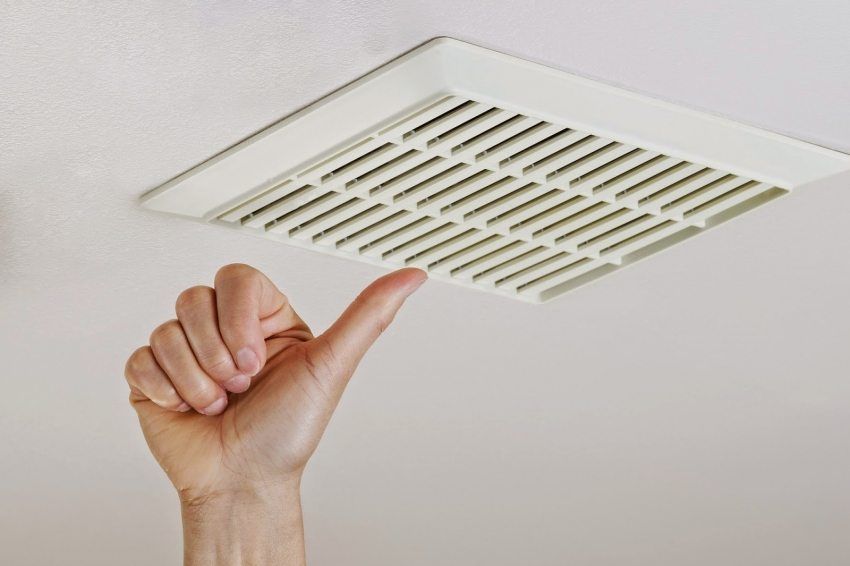
Fans in the arrangement of forced ventilation in the cellar may be two or one. One fan is mounted on the exhaust pipe from the storage side, and the air with it should be blown out. Two fans are an option for large rooms. In this case, the second is placed in the inlet pipe and serves to force air into the storage.
Fans can operate in several modes, so you can control the flow and outflow of air, and maintain the required temperature in the basement. Power can be supplied from the main power grid if the basement is located under a dwelling house or garage, as well as from a separate electric generator.
If you install forced ventilation in the cellar under the house, it will be easier to supply the fans with electricity than in a separate underground storage facility. In the latter case, wiring and equipment must be additionally isolated from moisture.
The second variant of the forced system involves the use of wind energy instead of electric. To do this, a special device is mounted on the exhaust pipe – a deflector that catches the air flow and transfers energy to the fans. The deflector is worth more details.

The principle of the deflector is that the air flow, dispelling on the diffuser, creates in the ventilation pipe increased traction, due to which air is circulated. The use of deflectors allows you to save on electricity, as well as increase the efficiency of the forced ventilation system. In addition, this design can be successfully used in the system of a natural type.
There are several types of deflectors. Consider the most popular ones.
ASTATO – A deflector that can be operated by an electric motor or by wind. The design of the device implies the presence of a special sensor that automatically disables the mechanical traction with sufficient wind strength. Such a device option is advantageous to use in cases where wind power is not always enough to ensure normal air circulation. The electric motor in such models is quite economical, so you can not worry about the overuse of energy.
Deflector-vane – rotates solely due to the force of the wind, good because it can adapt to any direction of air flow. The disadvantages include the fact that the bearings in the structure need regular lubrication and periodic replacement. In addition, if you use such a deflector in the cellar ventilation scheme, then note that at low temperatures its mechanism may freeze.
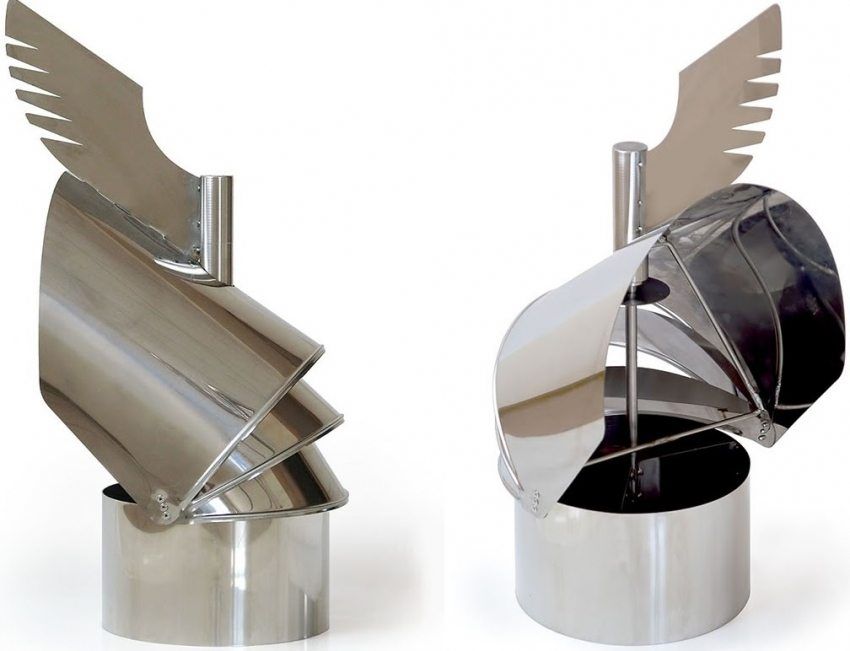
Static deflector – a relatively new model, which is characterized by the presence of an ejecting fan. At relatively high cost, it has such advantages as reduced noise level during operation, high efficiency, and moisture removal from the system.
Rotary Turbine – sets in areas with stable strong winds, so this design is not very popular.
In addition, there are spherical and H-shaped deflectors, Grigorovich deflectors and other options. The choice of model depends on the characteristics of the ventilation system and the area in which the basement is located.
Helpful advice! Grigorovich’s deflector is considered to be the easiest to manufacture, so if you install a conventional supply and exhaust ventilation system, it is best to use it.
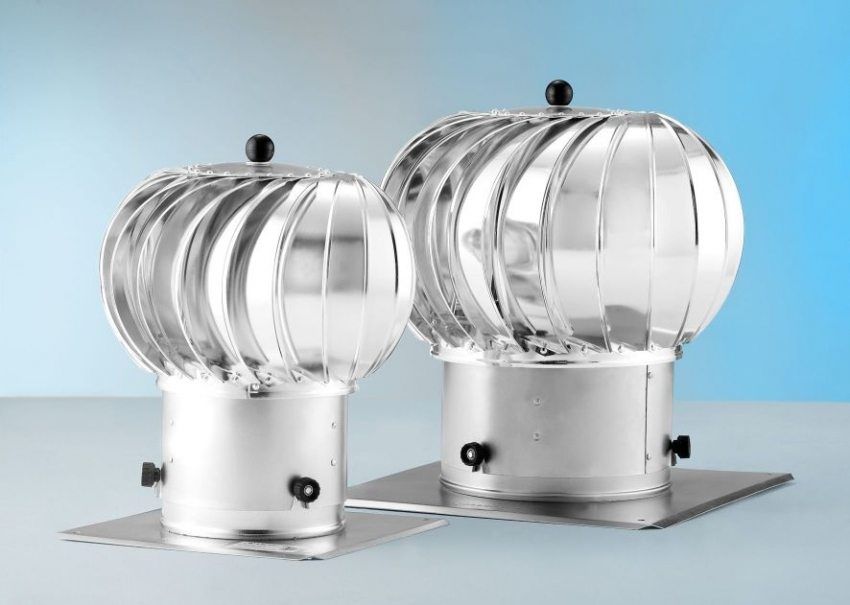
This device is often made of galvanized or stainless steel sheets, as well as plastic. Plastic models are cheaper than their steel counterparts, and look more attractive, but can not boast of durability. In addition, plastic vents are very sensitive to high temperatures, so you should not install them if the ventilation system combines the functions of the chimney.
Before proceeding directly to the manufacture of the deflector, it is necessary to calculate its parameters. The height of the deflector is calculated by the formula: H = 1.7xD, in which D is the diameter of the ventilation pipe. The width of the cap is equal to the diameter multiplied by 1.8, and the width of the diffuser is the diameter multiplied by 1.3.
Drawings of the ventilation deflector do it yourself on cardboard or thick paper, after which parts of metal or plastic are cut out of them. To work you need the following tools and materials:
- paper or cardboard for drawings;
- metal shears for cutting parts;
- sheet metal or plastic;
- marker or construction pencil;
- drill with drills of various diameters.
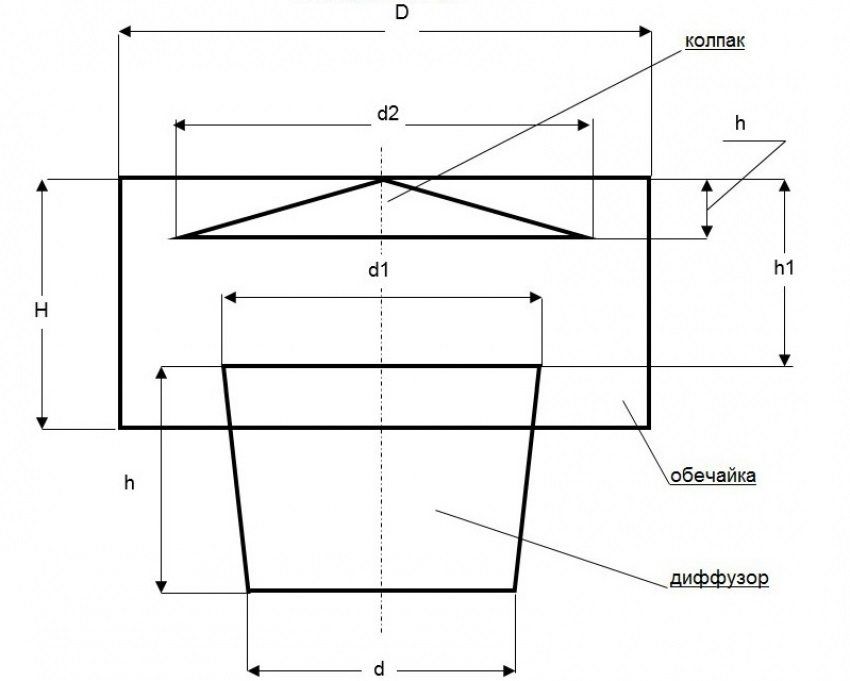
It is also recommended to use personal protective equipment when working, that is, special glasses and gloves. The manufacture of the deflector itself is made in the following order:
- The contours of the product are transferred from the drawing to the sheet of metal. This includes sweep cap, outer cylinder, pillars and diffuser.
- With the help of scissors for metal, these parts are cut.
- The connection of the parts to each other is carried out using a rivet gun.
- Ready deflector is installed on the tip of the pipe and secured with clamps.
When installing ventilation in the cellar, the installation of the deflector is a very crucial moment. Installation of the device is best done together, as the work is usually carried out at height. First, the lower cylinder of the structure is fixed at the outlet of the ventilation pipe. This is done with clamps or special bolts with dowels. After that, a diffuser is mounted to the cylinder, on top of which a protective cap is installed. The joints with bolts are recommended to be additionally treated with a special anti-corrosion compound.
On the drawing scheme in the cellar, the deflector occupies a very important place, therefore special attention should be paid to its assembly and installation.
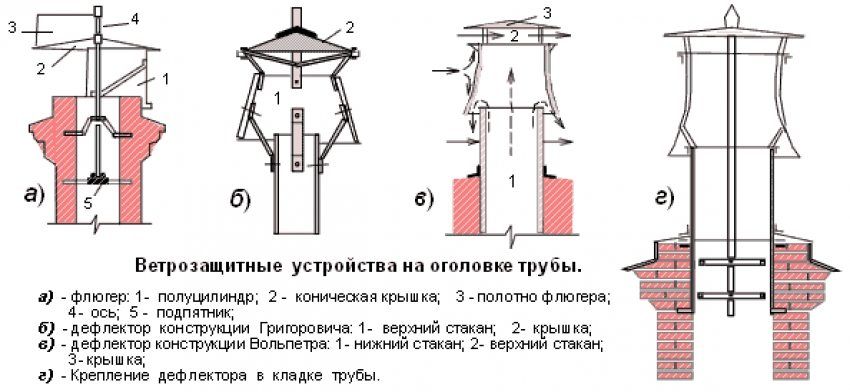
There are situations when storage is built in an area characterized by high groundwater levels or a climate with high humidity. High levels of moisture in the air can adversely affect the condition of food stored in the cellar.
In addition, when the ventilation system of the cellar with one pipe, moisture often condenses on its walls, and during the cold season it freezes. In this way, it can freeze in several layers and completely block the vent. To prevent this from happening, it is necessary to equip the forced ventilation system with a reinforced hood.
With the help of forced exhaust, you can significantly reduce the humidity in any type of cellar. How to make dry even a large enough room? To do this, you must use not only the ventilation system, but also pre-dry the cellar. To do this, you need to remove all the products from it before arranging the ventilation in the cellar and then carry out the drying work.

Drain the cellar in several ways:
- With the help of an iron stove or a brazier – a brazier or a bucket of coal is lowered into the basement, the fire is maintained until the room is dry enough. Before starting such a drying in the cellar, it is necessary to open the door and other openings. The fire is best ignited with sawdust or wood chips, and if necessary, the operation can be repeated several times.
- With the help of a candle – a candle is installed under the hood in the cellar. Proper use of this method implies small cellar size, otherwise it will not be sufficiently effective. Drying the basement with a candle is easier than using a roaster, but it takes longer. As a rule, it takes several days, during which the candles will have to be changed regularly.
- With the use of a special dehumidifier, it is a good option for large-sized storage facilities, which allows you to quickly get rid of the humidity in the room. It is possible to use a dehumidifier in addition to the usual system of supply and exhaust ventilation, if moisture is often accumulated in the cellar.
It is necessary to choose a suitable variant for draining a basement depending on its size, as well as whether you have the time and possibilities. Installation of an effective ventilation system will allow to do this less often, but even the highest-quality ventilation will not be able to completely eliminate the need to dry the wet cellar, if it was not waterproofed during the construction of the room.
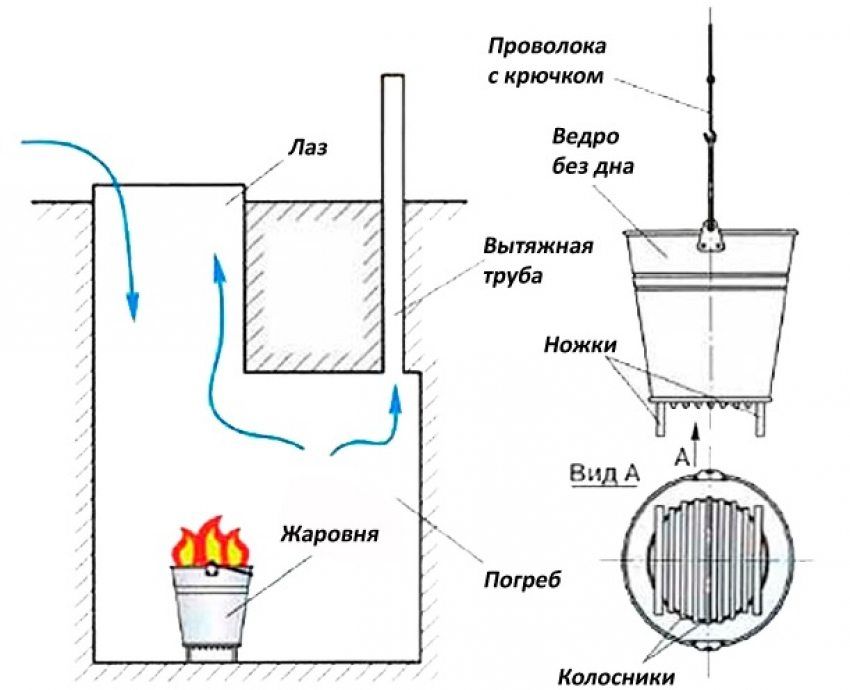
There are several options for making the cellar of a different type colder. You can initially dig a hole at a greater depth, you can pay more attention to thermal insulation, and you can use special climate control systems. According to the type of temperature control, there are two different types of ventilation systems:
- Automatic – works offline. In such a system, there are special sensors that monitor the temperature in the cellar and turn off and turn on the fans when it needs to be lowered or raised. The main element of such a system are different versions of temperature controllers for the cellar, which can be bought in specialized stores.
- Mechanical – works with the direct participation of a person who monitors the level of temperature and humidity in the storage. In such a system, the intensity of the operation of the fans, as well as the position of the dampers on the intake and exhaust pipes, is adjusted manually.
Helpful advice! When choosing the type of ventilation system, be guided by how accurately it will be necessary to maintain the temperature. If the tolerances are more than two degrees, then a mechanical system will do. Otherwise, it is better to give preference to automatic control of the microclimate.
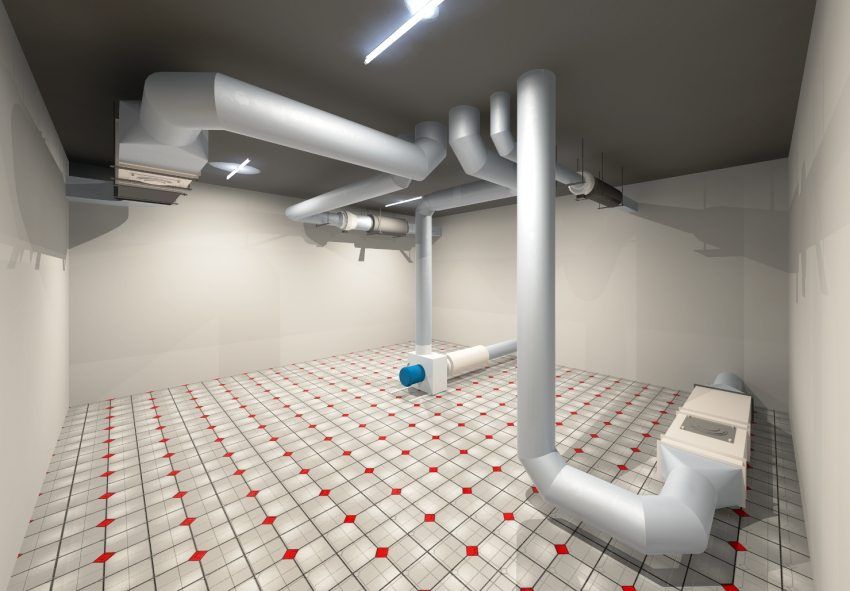
Self-made ventilation schemes in the cellar involve the use of various types of pipes. To date, the most popular of these are asbestos cement and low pressure polyethylene.
Asbotsementnye ventilation pipes are similar in appearance to slate, so they are also called slate. They are characterized by a high level of durability and reliability, as well as durability and resistance to corrosion. They are sold in long lengths, so the ventilation system can be made from whole parts of pipes. Polyethylene pipes, most likely, will have to be welded together, for this you will need special tools and skills.
Less commonly, metal pipes are used for the air circulation system. They are cheap enough and simply installed, but the metal is susceptible to corrosion and rots quickly in the ground. To prevent this from happening, metal pipes can be coated with a layer of anti-corrosion enamel before instillation into the ground or additionally protected from moisture using waterproofing materials. In addition, moisture condenses more strongly on a metal surface than on a plastic one, so it is better to use them in combination with a forced ventilation system in the cellar. How to make the right hood of metal pipes? This is best done for storage under a house or garage.

When using any material, the exhaust and intake pipe openings must be protected from moisture and debris. To do this, they installed a special cap and grille, which can be made of any materials.
In order to properly circulate the air in the cellar, you can use several different types of fans. By the principle of operation and location, they are divided into channel and axial.
Duct fan characterized by an average level of performance and can be installed anywhere in the ventilation pipe. In addition, it consumes a bit of electricity, so this option is well suited for saving money. The most efficient are amplitude channel fans.
Axial fans installed near exhaust or air inlets. They are more demanding in terms of electricity, but also provide a more powerful air flow. Complete with a fan on the outlet pipe of the system, a special valve is installed that prevents cold air from entering the room.
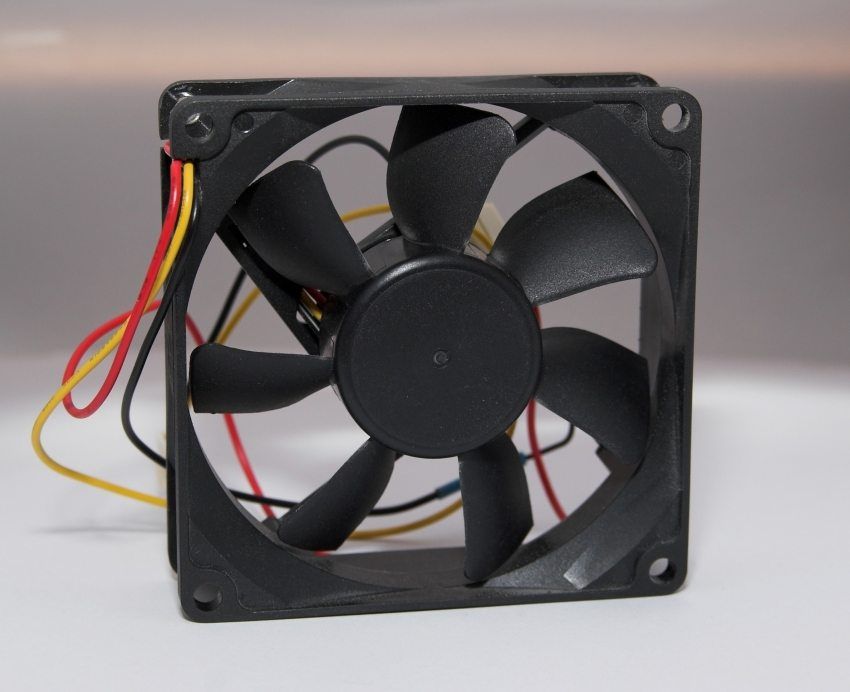
After you have decided on the type of air circulation system, selected the type of pipes and fans, manufactured or purchased a deflector, dampers and other components, you can begin to install the hood. This is done in the following order:
- If you install the ventilation system after the storage has been built, then a hole for the ventilation pipe is drilled in its ceiling.
- A vent is mounted in the hole under the ceiling. On the street, its end should be raised above the surface not less than 15 cm.
- In the wall opposite to the exhaust hole, a hole is drilled near the floor. It should be located not lower than 2 cm, but not higher than 5 cm.
- The supply pipe is mounted in the hole. From the outer part of the cellar, its opening must be too high, since there must be a pressure difference between the inlet and the exhaust to create a natural draft. This is more relevant for the system of natural air circulation, but it makes sense for the forced.
- The end of the inlet pipe in the street is closed by a baffle or a special protective grill.
- Inside the cellar, special valves are installed on the pipe, the regulation of the gap of which will allow you to adjust the intensity of air circulation in the system.
After the system is mounted, it is necessary to check the efficiency of the hood in the cellar. How to do it with the help of available tools? For this, a sheet of paper can be brought to the inlet of the inlet pipe. If it moves, then the system is working properly. Another option is to check with lighted paper or another source of smoke. Smoke must quickly dissipate and be drawn out of the basement.
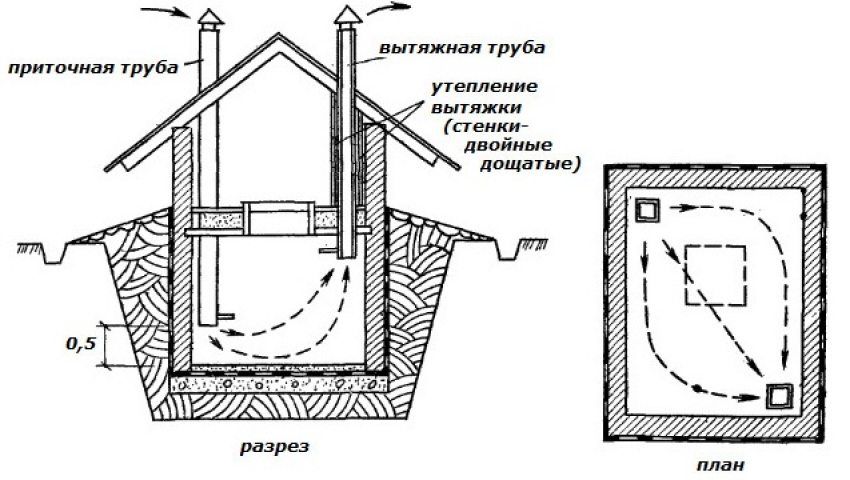
Regardless of what type of air circulation system for the basement you have chosen, a number of general points should be taken into account during installation:
- It is best to lay the ventilation system at the construction stage of the storage. In this case, it is necessary to leave special channels in the walls into which the ventilation pipes will be subsequently installed. So you will save not only time and effort, but also financial resources. The ventilation scheme should immediately be included in the project basement;
- How to make cellar ventilation in a private house even? For this you should use the supply and exhaust pipes of the same diameter. If the basement is characterized by high humidity, the diameter of the exhaust pipe may be slightly larger. Remember that in no case should the intake pipe be larger than the exhaust, as this will begin to trap air inside the storage facility, which can lead not only to food spoilage, but also to increased gas pollution of the room. The last moment is dangerous to human health;
- Do not place the supply and exhaust pipe next to each other. This will lead to poor overall system performance. It is best if the holes are located on opposite walls of the basement;
- if the cellar is located under an outbuilding, the entrance hatch or door can play the role of a chimney;

- Plastic pipes for sewage can be used as ventilation ducts. They are characterized by a suitable diameter and are relatively inexpensive;
- part of the exhaust pipe, which is located outside the cellar, should be properly insulated. Otherwise, condensate may form on its inner surface during the cold season, which, when freezing, is capable of blocking the exhaust vent.
Helpful advice! It is possible to insulate the pipes so that they do not form condensate, not only in the part where they come to the surface, but also along the entire length.
There are many options for how to do different types of ventilation in the cellar with your own hands. You can use one or two pipes for this, arrange air circulation by natural or forced means, install fans, deflectors, temperature control systems and climate sensors.
From the effectiveness of the ventilation system directly depends on the shelf life of products, as well as health, if we are talking about the gym or other frequently visited room. It is best to lay the drawing scheme directly into the storage plan, so you will spend less time on its installation and will be able to use the basement immediately after its completion.

